Dunrie Greiling's Blog, page 5
September 26, 2016
New Yoga for Scoliosis Book
You might think a curved and twisted spine may make yoga impossible. It’s the opposite: yoga makes living and breathing with scoliosis better. And Elise and DL’s new Yoga for Scoliosis book will help you do yoga better.
Through working on my posture and breath in yoga, I have learned how to reduce my thoracic curve, de-rotate my spine, and breathe into areas which are compressed. When I don’t practice, I know it. My back aches more with twinges and tightness. When I practice, I feel more integrated, graceful, and free.
Yoga for Scoliosis book
Yoga for Scoliosis book
Elise Browning Miller and nancy DL heraty, two great yoga teachers, just released Yoga for Scoliosis: A Path for Students and Teachers. It is a wonderful book, clearly written with beautiful photographs and illustrations. It’s also quite practical: its spiral-bound pages lay open perfectly so I can consult it in the middle of my sequence.
This Yoga for Scoliosis book describes scoliosis, its four main patterns, and the benefits of yoga for scoliosis. The authors include instructions for beginning your own home practice (including advice about props) and then go into asanas and pranayama.
Covered asanas include:
standing posesseated posesback poses, backbends, and back strengtheners,twisting poses,supine and side-bending poses,core strength poses,inversion poses, andbreath awareness for scoliosis.Each asana is well-described with at least one photograph, instructive text, variations, and specific adjustments for each pattern of scoliosis. The book concludes with seven yoga for scoliosis practice sequences.
The book concludes with seven yoga for scoliosis practice sequences. These sequences are easy to skim and each refers back to the full instructions for each asana in the sequence.
About the AuthorsOver the years, I have taken several workshops and classes from Iyengar yoga teacher Elise Browning Miller. Elise is based in Palo Alto, and she teaches all over the US and even internationally. I have followed her to Cleveland, Chicago, Kalamazoo, and Sonoma. Working with Elise has taught me how to use yoga to be stronger, more joyful, and work with my scoliosis rather than suffer with it. With her help, I have less pain and am lighter in my own body. Who wouldn’t want that?
When I have attended Elise’s workshops in Chicago, I met and worked with DL as well. DL co-authored the book with Elise and is a gentle and nurturing presence in workshops.
Get the Book!If you teach yoga or do yoga and have scoliosis, get the book! You won’t be disappointed. You can purchase the book from Elise’s website.
The post New Yoga for Scoliosis Book appeared first on Scientific Ink.

August 11, 2016
Learn Google Analytics via its Demo Account
How do you learn Google Analytics without practice? How can we train new people when analytics accounts are held private – like trade secrets.
Reading vs. Learning Google AnalyticsYou can find lots of resources to teach yourself Google Analytics. One of the very, very best is the informative, insightful, and thought-provoking writing of Avinash Kaushik. If you don’t already follow his blog – Occam’s Razor, do it! You should also subscribe to his email newsletter, The Marketing < > Analytics Intersect.
Yet, reading gets us only halfway. I learn best when I can apply my new knowledge directly and immediately. Don’t you?
When we wrote Internet Marketing Start to Finish, I sought an open Google Analytics account for students (see my post on the Pure Visibility website). For its instructors’ resource guide, I offered access to the analytics on this site. While better than nothing, it remained incomplete and unsatisfying. For instance, this site has no AdWords or e-commerce.
Demo Account to Learn Google Analytics!Earlier this month, Google opened up a great resource for learning – a demo e-commerce account. From Google’s Official Announcement:
It can be difficult to gain practical experience since not everyone has access to a fully-implemented Google Analytics account. To fix this we’re introducing a fully functional Google Analytics Demo Account, available to everyone (get access here).
This account has AdWords data, e-commerce functionality, and more. Hip Hip Hooray!
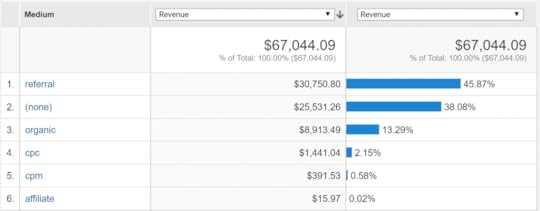
Learn Google Analytics in the Demo Account. Shown: revenue by medium for the Google Merchandise Store
I love this. Very cool. Have you taken a look? What do you think?
Learn MoreAvinash Kaushik shared more info on the Demo account and how you might use it available via Occam’s Razor post “Be Real World Smart: A Beginner’s Advanced Google Analytics Guide.”
The post Learn Google Analytics via its Demo Account appeared first on Scientific Ink.

May 24, 2016
Test Web Forms Frequently
OK when something happens twice in the span of a week, it’s officially a theme. Test web forms frequently. Your leads are hard won and too important. Don’t let your tech to get in the way.
Even if you’ve made no changes to the form, other changes can interfere. Over the span of the last week, I’ve seen personnel changes in the business and scripts elsewhere on the website cause problems. Watch your step: double check that your forms are working well and going to the right place, at least monthly.
Why Use Forms?What do you want people to do when they visit your website? If you want them to get in touch, you need to give them a way to do it.
Sometimes small businesses like to post an email address on a website as a contact method. Yet, email addresses on websites are hard to track. Your analytics script will only track whether the person clicked the email address (to open a message to you). It will not track the actual email being sent, because the message is sent from the visitor’s email program, not from the website.
I also personally dislike pop-ups, where a link opens in another program (such as a PDF or email app). I find the context shift jarring.
Web forms are trackable. Your web analytics can track the form submission as an event or can track visits to a “thank you” page.
Web forms are easy to deploy. Although I happen to like Contact Form 7 for WordPress, there are lots of options, free and paid.
Why Test Web FormsYet, like everything internet marketing, web forms are not set and forget. It’s basic quality control to check the forms at the site’s or the form’s launch. While it may seem redundant to keep verifying that all is well in the weeks and months after the form has been published, it’s a critical business process.
Cautionary Tale #1 – Personnel ChangeA few months after the launch of a website, a team member moved on to another role with a different company. His email address was where the web form submissions went, and so became, unintentionally, a dead letter box. A prospect contacted this company after not receiving a reply from the company.
Lessons LearnedClean up your email accounts at personnel transitions. Don’t let untended email accounts cause communication bottlenecks.Use role-based rather than “personal” email addresses for critical business processes such as leads and communications.Avoid having a single point of failure in a key business process.Cautionary Tale #2 – Script ConflictYesterday, someone contacted me via LinkedIn and let me know that she had tried to use the form on this site and it had not worked. Although the form did work, her message stayed on the screen after she hit “submit”. So she got in touch another way and let me know. I was able to debug the issue and the form gives useful feedback again.
How to Test Web FormsInspect their settings – review where the form contents go (to a database? to a person?)Send a test email and verify it is received by all parties and systems.Check that the form provides useful feedback/confirmation.Do this monthly. I set a repeating reminder in my task manager.Happy prospecting.
The post Test Web Forms Frequently appeared first on Scientific Ink.

May 17, 2016
Just Good Enough Websites
The tools we use to create websites have changed during my marketing career. In the beginning, you had to know a little about coding. Today’s services allow the non-coder to create a more than just good enough website.
Web Dev back in the DayIn the early 2000s, my employer had a small site designed by a professional. The designer handed off images to our team that one of the software developers turned into HTML. Our homepage was a cut-apart image, its pieces reassembled and held in an invisible table. Different parts of that image were hyperlinked to different pages on the site. I edited that website’s content by editing individual HTML pages in a text editor.

Tools, made available with a creative commons license by Richard on flickr
Just Good Enough Websites 2016We have come a long way since then.
Services like WordPress, Wix, Weebly, and Squarespace offer simple ways for non-programmers and non-designers to have lovely and functional websites, beyond just good enough. If you subscribe to any podcasts, you’ll hear persistent ads for drag and drop website-making platforms.
I have opinions on platforms (this site is in WordPress and has been since 2006). Yet all these content management systems make things pretty easy for the non-technical user.
I still use my HTML and jump into the text pane of these platforms if the WYSIWYG editor refuses to format things how I want, but generally these platforms work just fine.
I’ve consulted on several homegrown websites created and operated by entrepreneurs and small businesses. Here’s how to make sure the website is good enough:
Content Optimization TipsDo keyword research, use the words that other people use often, and write to topics in demand that are relevant to your businessBefore you publish, use a tool to review your content for keyword optimization. On WordPress, Yoast SEO is my go-to, and its free version is very full-featuredTechnical Optimization TipsMake sure you have a mobile-ready design or theme – assess your site’s mobile friendliness with the Google Mobile Friendly TestSubmit your sitemap.xml and review any errors in Google Search Console and Bing Webmaster ToolsBonus/Advanced Tip – Add relevant structured data, for example mark up your store/office addresses. You can use the Raven Tools site Schema-Creator.org or Raven’s Schema Creator plugin for WordPressCultivate your ConnectionsInterconnect all of your business social profiles with your website. You should be able to move easily between all of your web properties. Make sure there’s a link from every social profile back to your website and be sure to link to all of your relevant, active profiles from your website.Add social sharing to your website. Yes, people can copy any link from your site and share to any of their chosen social sites. Yet, a visual prompt to Pin it, Share it, Tweet it, whatever it helps remind them and makes it easy. In WordPress, plugins like AddtoAny Share buttons automate social sharing.Any basics I have I missed?
The post Just Good Enough Websites appeared first on Scientific Ink.

February 8, 2016
What’s in a name? Industry groups differ on life science and biotech terms
Last week, I attended the Michigan Bio-Industry Growth Summit. The event bag included reports from sponsoring organizations MichBio, Business Leaders for Michigan, and the University Research Corridor. Attendees also received a report from the national Biotechnology Industry Organization (BIO). In these reports, I noticed some variation in names for the life science or biotech industry.
Life science industry leaders use different names
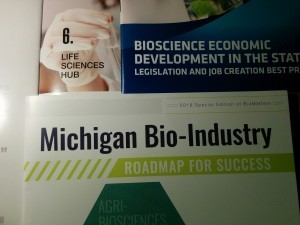
Handouts from the Michigan Bio-industry Growth Summit – showing different terms for life science or biotech
MichBio titled its report the Michigan Bio-Industry Roadmap for Success (Roadmap available from MichBio site).
BIO named its report Bioscience Economic Development in the States: Legislation and Job Creation Best Practices (download the PDF from BIO).
In its New Michigan: The 2015 Report on Michigan’s Progress in Leveraging Six Opportunities, Business Leaders for Michigan called “Life Sciences” one of the six opportunities for the state (download the report from Business Leaders for Michigan).
In its 9th Annual Economic Impact Report (2016), the University Research Corridor (URC) reported on “Life Sciences” in Michigan (read the report at the URC site).
I imagine that in each report’s editorial meeting, a fair bit of time was spent selecting each noun and verb for the title and section headings. Perhaps MichBio went with Bio-Industry to be more inclusive of activities that broaden the definition of biotech, or to differentiate commercial activities from primary research, I’m not sure. They are the domain experts, so I trust their choice was for a good reason.
I asked Google which name was “better”
Yet, for Twitter and for my first post about the event, I opted for biotech. For Twitter, “biotech” was shorter than “bio-industry”, and short and sweet is better in that medium.
When I got back to the office, I did more research. Google Trends gave me the popularity of these terms in searches. Google Trends aggregates all searches, and therefore emphasizes what the general public calls the industry.
Worldwide life science searches
United States life science searches
Michigan life science searches
As you can see in the graphs, the terms “biotech” and “biotechnology” are more popular worldwide than life science, bio-industry, or biosciences. When we look only in the United States, life science searches are similarly popular to those for biotechnology, but biotech is consistently higher (except for September in each year when life sciences jumps up to or above biotech’s level). The Michigan data is noisier but appears similar to the US as a whole. In all regions, bio-industry and bioscience lag the other terms. If I keep playing with the terms, plurals matter for life science and biosciences, so I chose the most popular variant for these graphs – life science and biosciences.
Closing Thoughts – specific vs. popular phrases
The cross-industry groups, Business Leaders for Michigan and the University Research Corridor, used the more general and more popular term for the industry (life sciences) than did either of the associations with “bio” in their name. Over time, the bio-groups may teach the general population the new terms, search popularity is volatile. Yet, more commonly-used terms (e.g. biotech or life science) should go farther in the near term. Sometimes experts know and use too many words for our own good.
By using “bio-industry”, MichBio might be limiting the reach of its Roadmap. MichBio’s Roadmap is a call-to-action to its members, it is speaking to other experts. Fine distinctions matter to experts, but they might muddy the communication to regular folks. The association and the Roadmap also needs to speak to non-experts—such as legislators and educators. If I were at that editorial meeting, I would have brought search data like this to the table and argued for the more commonly-used terms in the report title.
When I tweeted about the event, I picked #biotech, but within Michigan, life science would have been just as popular and I chose that as the focus keyword for this post.
The post What’s in a name? Industry groups differ on life science and biotech terms appeared first on Scientific Ink.

February 4, 2016
Michigan Biotech: MichBio Growth Summit – February 2016
Industry association MichBio organized yesterday’s bio-industry growth summit in Lansing. This Michigan biotech event featured national and regional leaders, including legislators (agenda here).
Michigan Biotech Roadmap for Success
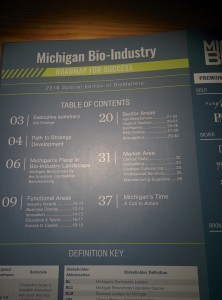
Table of Contents – Michigan Bio-Industry Roadmap for Success
MichBio also launched their Michigan Bio-Industry Roadmap for Success. This roadmap was developed through interviews, focus group, surveys, and comparison to peer states.
Event attendees received a print copy of the executive summary for the roadmap (~40 pages), still fragrant from the printer. Director Stephen Rapundalo, Ph.D., presented the highlights to the attendees. The Roadmap provided competitive benchmarking of Michigan in total bio-industry employment, expenditures, grants, patents, and venture capital. For employment, the roadmap breaks the bio-industry category into subcategories, specifically:
agri-biosciences,
drugs & pharmaceuticals,
medical devices & equipment,
research, testing & medical laboratories, and
bioscience-related distribution (logistics).
The roadmap evaluated Michigan’s rank and then provided specific recommendations for industry growth, business climate, innovation, education & talent, and access to capital. Rapundalo announced that a full version of the Roadmap should be released this month. I will post a link to any online documents here if/when they become available.
Recurring Themes – Michigan Biotech Education and Talent
A recurring theme from the panel and from attendees talent. Panelists called for biotech-oriented education for entry-level positions. Panelists discussed having to recruit talent back to Michigan from the coasts for senior/specialized biotech leadership positions.
Being a digitally-focused person, I did some live-tweeting of the event and made sure to connect in person with others who were tweeting. Here are a few example tweets from my own and others takeaways from the event.
MichBio CEO Rapundalo presents the Roadmap: Building MI into a biosciences leader pic.twitter.com/c8YasqxW41
— MichBio (@michbio) February 3, 2016
Today @michbio #GrowthSummit #biotech #bioscience & speaking on state advocacy efforts-5 states enacted laws all 5priorities @AdvaMedUpdate
— Liz Powell (@G2Gconsulting) February 3, 2016
@DrRogerNewton – emerging theme of @michbio #industrygrowthsummit need to address MI education at all levels to secure talent pool @urcmich
— Brit Affolter-Caine (@BritanyAffolter) February 3, 2016
Talent mgt. is a recurring theme from panelists at #michbio #biotech growth summit // @michbio pic.twitter.com/e3I5AkEqx0
— Jenn Rohl (@jennrohl) February 3, 2016
Roger Newton, Mark Leeahy and Liz Powell discuss bio-industry in #michigan at @michbio Growth Summit @medicaldevices pic.twitter.com/4XxcgZInLu
— The SearchLite (@TheSearchLite) February 3, 2016
#Michigan Sen @rebekahwarren thank you 4 your leadership in advocating 4 #bioscience industry & #innovation @michbio pic.twitter.com/cgtFwFdpmA
— Rachele Downs (@rachelejdowns) February 3, 2016
.@MarkJForchette — playbook for #biotech success: vision, technology, talent (character is key), and culture // @michbio
— Dunrie Greiling (@dunrie) February 3, 2016
The post Michigan Biotech: MichBio Growth Summit – February 2016 appeared first on Scientific Ink.

August 24, 2015
Gone Back to School
I’ve gone back to school, college actually.
Back to School, made available via Creative Commons by Leland Francisco on Flickr
I’m pulling down the shingle here at Scientific Ink for the next several months. I’ve taken a position at Washtenaw Community College – I will be Interim Executive Director of Marketing & Web Services through January 2016. This new position will keep me busy enough that I will not be taking on client projects.Thanks and keep in touch!
The post Gone Back to School appeared first on Scientific Ink.

July 30, 2015
Word to the Wise: Stamp out End-Runs
Anyone who has talked with me about my approach to structuring and managing teams and companies has likely heard me talk up EOS, the Entrepreneurial Operating System.
We used a great EOS coach, Duane Marshall, at a prior employer. I have learned a lot from Duane and from Gino Wickman’s books about how to focus on the right things, what to ignore, and how to get things done.
I like this short video on how to stamp out communication circuits that undermine the structure of a company. I have been guilty of avoiding the difficult conversation by going indirectly, and I’ve seen the consequences when I’ve been circumvented. Never good. At best, it just wastes cycles by having a conversation without the right people gathered together. At worst, it undermines key relationships and pulls the team apart. So much simpler to just stop it in its tracks.
Listen to Mark Winters, co-author with Gino Wickman of Rocket Fuel, explain how to avoid end-runs around managers and integrators.
The post Word to the Wise: Stamp out End-Runs appeared first on Scientific Ink.

July 20, 2015
Gaming the System: have we reached peak customer experience survey?
Surveying the customer seems like a good idea to find out ways to improve. Yet, I’ve been on the receiving end of customer experience surveys that show me we’re doing it all wrong.
Anyone who has purchased a car or who has had their car serviced recently by a car dealership is likely aware of the 10-point customer experience survey that arrives, via email, after the dealership visit. Other interactions with their customer service (say to troubleshoot the connection between said new car and the proprietary little app system that runs the electronics) also trigger a “rate our customer service” email. All these chances to provide feedback are good, right? Nope.
When each interaction with your service creates more work for me, the customer, I wonder. Also, the sales operation doesn’t feel open to actual feedback, it seems they’re only interested in the goal – getting the top mark. They show this in unsubtle ways. Visual cues for how the dealership would like to be rated are on the back of the salesman’s cubicle and on the wall facing the seats in the service department waiting area.
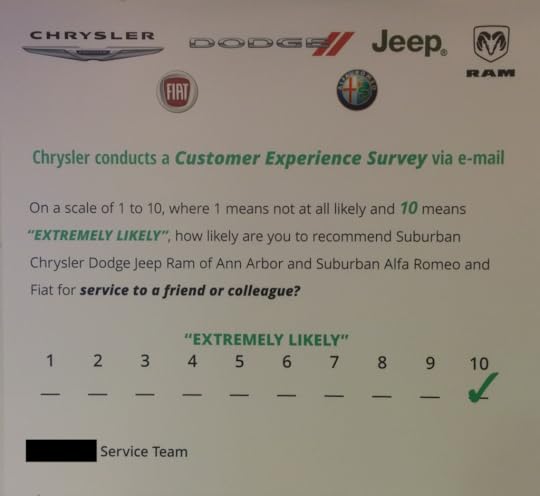
Meaning – please rate us “extremely likely” to recommend!
Before I switched to a Chrysler product, I had a car with another brand name. And that dealership sent very emotive letters ahead of the survey, essentially saying if you cannot give us a 10, please let us know so we can correct it before you fill out the survey. Basically, let’s keep this between us, don’t tell Papa Franchise/OEM about any frustration.
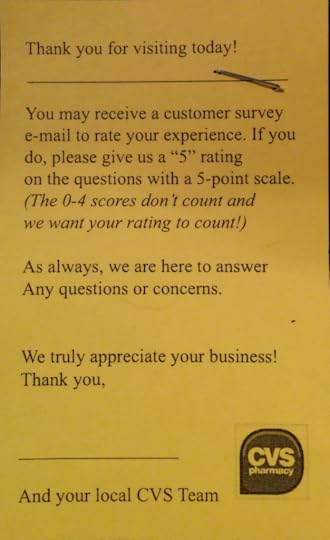
Please give us a “5” rating on the question with a 5-point scale. (The 0-4 scores don’t count and we want your rating to count!)
Earlier this year, I got this form stapled to my receipt at the drugstore. It says that I may receive a survey, and if I don’t answer a 5 (top score for them) my response “won’t count”!
This pharmacy’s assertion that a rating below “5” won’t count cannot be true, and this note is the opposite of customer service. It’s just forcing the customer to be involved in gaming a corporate system. Yuck. With the people who are the subject of the surveys (sales and customer service folk) specifically asking to subvert the intention of the survey….how can we take this data seriously?
We know from online ratings that people really don’t bother to review a company or an experience unless they’re thrilled or torqued off. Yet, most of the experiences we have with brands, stores, and car dealers are somewhere in the middle of horrid to spectacular. It’s unrealistic to expect they’ll be spectacular 10.0 across the board all of the time. And it’s particularly silly to ask your customer to enable this charade.
Don’t bother your customers
Bothering the customer to give you top marks on a survey isn’t a good customer experience.
I’ve started a new behavior in response to this: I won’t fill these silly things out.
If I can’t give the customer service top marks, but it isn’t the agent’s fault (e.g. the issue is mechanical or technological) I have a hard time rating the interaction at all. I can’t give it a 10 because I’m still unsatisfied. But the agent was nice and at least sympathetic to the weirdness of the [insert technical or mechanical issue here]. So, should I be honest and say they’re eroding my faith in their brand but they hire friendly people to take the hit? That’s not an option in the survey, so I just delete the customer experience surveys now.
The post Gaming the System: have we reached peak customer experience survey? appeared first on Scientific Ink.

March 23, 2015
Customer Service: Actions “behind the scenes” matter to customer experience
What is your team doing when they aren’t “customer-facing?” Hint, it influences the customer experience too.

Welcome, made available by halfrain via Creative Commons on Flickr
There is a fancy grocery in Ann Arbor where I sometimes shop (and that will go unnamed). Generally, the folks here are friendly at the cash registers and at the cases where I order seafood, meat, or prepared food. Yet, I’ve noticed that the staff at this grocery are in a hurry when they’re in the aisles. When I’m shopping with a cart, I’ve had to “pull over” and wait for staff hurrying by to pass me.
When this happens, I wonder what’s so important in the back room—a smoke break, the punch clock, and angry manager with a clock? I imagine that the store’s leadership has stressed quickness or efficiency over courtesy (a customer experience failure). In my head I rewrite my shopping list to frequent other stores.
There is another “fancy” place in town – Zingerman’s. I visited a friend at the Zingerman’s Bakeshop recently, and he walked me around behind-the-scenes. Everywhere we went in the facility, people stopped what they were doing (at their computers, wheeling a hand truck through a loading area…) and greeted me. I’m sure they had as much to do as the staff at the other location, yet they weren’t in a rush, seemed genuinely glad to meet me, and meeting each of them was a pleasure.
Zingerman’s has published their mission and guiding principles. They emphasize two relevant phrases in their mission:
“giving service that makes you smile” and
“showing love and care in all our actions.”
Through stopping to greet me, the Zingerman’s team exemplified courtesy and the mission of the company. While I didn’t yearn for a chat with the team at the other store, I would prefer not to feel “in their way.” I don’t shop there as often as I might, and I don’t want to work there.
So the question becomes—what values do you promote in your organization? Values and intention matter whether it is a knitting group, a writing circle, a start-up, or an established business.
What experience do you want newbies, visitors, new team members, and the old guard to experience? Because it is those values that shape the behavior of your team and the experience of your customers.
The post Customer Service: Actions “behind the scenes” matter to customer experience appeared first on Scientific Ink.


![[066/365] Back to School](https://i.gr-assets.com/images/S/compressed.photo.goodreads.com/hostedimages/1440554752i/15991846._SX540_.jpg)


